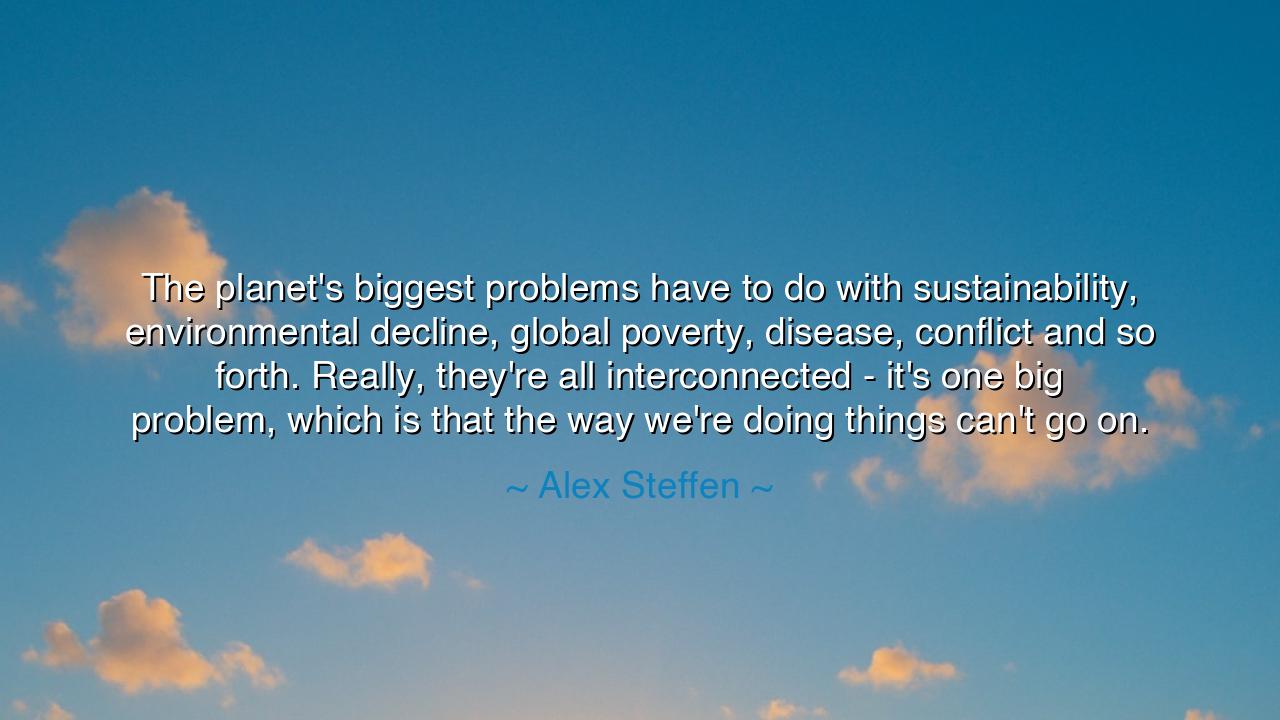
The planet's biggest problems have to do with sustainability
The planet's biggest problems have to do with sustainability, environmental decline, global poverty, disease, conflict and so forth. Really, they're all interconnected - it's one big problem, which is that the way we're doing things can't go on.






Hear the voice of Alex Steffen, who speaks not with idle complaint but with the gravity of one who beholds the whole earth: “The planet’s biggest problems have to do with sustainability, environmental decline, global poverty, disease, conflict and so forth. Really, they’re all interconnected—it’s one big problem, which is that the way we’re doing things can’t go on.” These words, though plain, are as thunder in their meaning. For he declares that the crises of our age are not scattered, but woven into a single cloth of peril, and unless we change our course, that cloth will become the shroud of humanity.
The meaning of this saying lies first in its recognition of interconnection. Many believe that environmental decline is one issue, poverty another, disease another still, and that each can be solved in isolation. But Steffen reminds us that these threads are bound together. Polluted air and water spread sickness; poverty leaves communities vulnerable to both disease and conflict; wars ravage the land, leaving behind famine and ruin; the quest for short-term wealth drives the destruction of forests and seas. All these are but faces of the same beast: a way of life that consumes without balance, that takes without restoring, that moves forward blind to consequence.
History offers proof of this binding of crises. Consider the fall of Easter Island. The people cut down their forests to build their monuments, seeking glory without thought of limits. As the trees vanished, so too did the soil’s fertility, and with it, food. Hunger brought conflict, and conflict brought collapse. What began as environmental decline grew into poverty, disease, and war—a cycle of ruin born of unsustainable choices. In this story, ancient yet familiar, we see that Steffen’s warning is not for the future only but echoes lessons already carved into the past.
His words also remind us that the heart of the crisis lies not in one event, but in the pattern of the way we’re doing things. For centuries, humanity has lived as if the earth were infinite, as if seas could endure endless nets, as if air could swallow endless smoke, as if soil could yield endlessly without rest. Yet the earth, though vast, is not without limit. The ancients knew this: farmers rotated their crops to preserve the land, shepherds managed their flocks to protect the pasture, and seafarers respected the seasons of the sea. But modern man, forgetting wisdom, has pursued growth without balance, and thus faces the breaking point Steffen describes.
There is heroism hidden in his lament. For to name the crisis is the first step to confronting it. To see that poverty, disease, conflict, and environmental decline are not separate evils but linked is to recognize that their solution, too, must be united. One cannot heal the planet without lifting the poor, nor end wars without sustaining the land, nor cure disease without clean air and water. The vision Steffen calls for is one of wholeness, a wisdom that sees the earth as a body, where every wound weakens the whole and every healing strengthens it.
The lesson for us is clear: we must change the way we live. Let each person reduce waste, protect water, and honor the soil. Let nations build economies not upon endless consumption, but upon renewal. Let leaders see beyond short terms of power and plan for generations unborn. And let all people understand that to heal poverty is to heal the planet, and to heal the planet is to heal themselves. Sustainability is not a burden, but the path to survival, peace, and prosperity.
Therefore, take action in your daily life: choose food that is grown with respect for the earth, reduce the burning of fuels that poison the air, support leaders who speak for future generations, and offer aid to the poor, who are most vulnerable to the storms of decline. Teach your children that all life is one web, and that to pluck at one strand is to shake the whole. For Steffen’s words remind us that the world is not divided, but bound together, and so too must be our response.
So remember this saying: “It’s one big problem… the way we’re doing things can’t go on.” Let it not fill you with despair, but with resolve. For every generation is tested, and this is our trial: to abandon the path of ruin and walk the path of renewal. If we succeed, we will not only save ourselves, but leave behind a legacy of wisdom, proving to future ages that when the earth was imperiled, humanity awakened, and chose to live in harmony once more.






AAdministratorAdministrator
Welcome, honored guests. Please leave a comment, we will respond soon